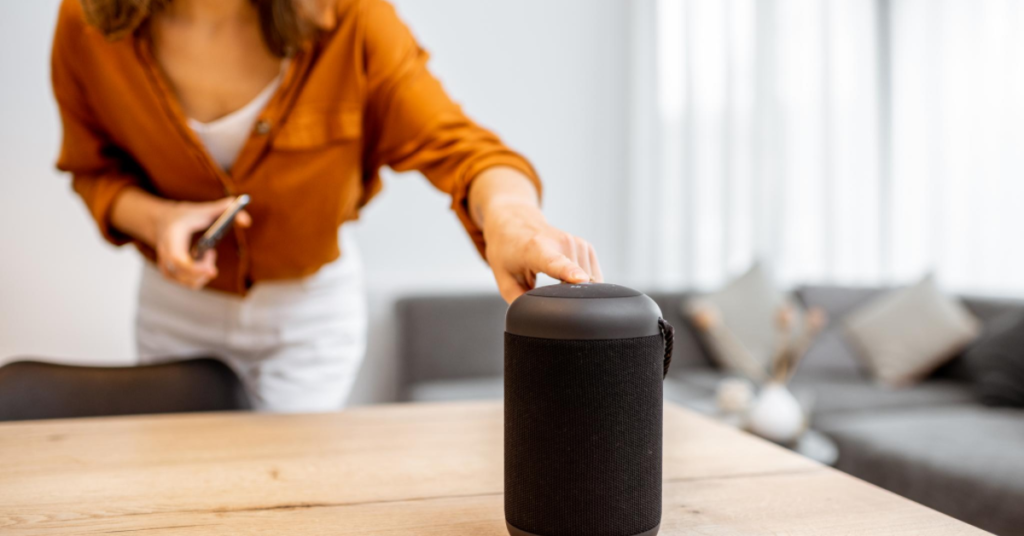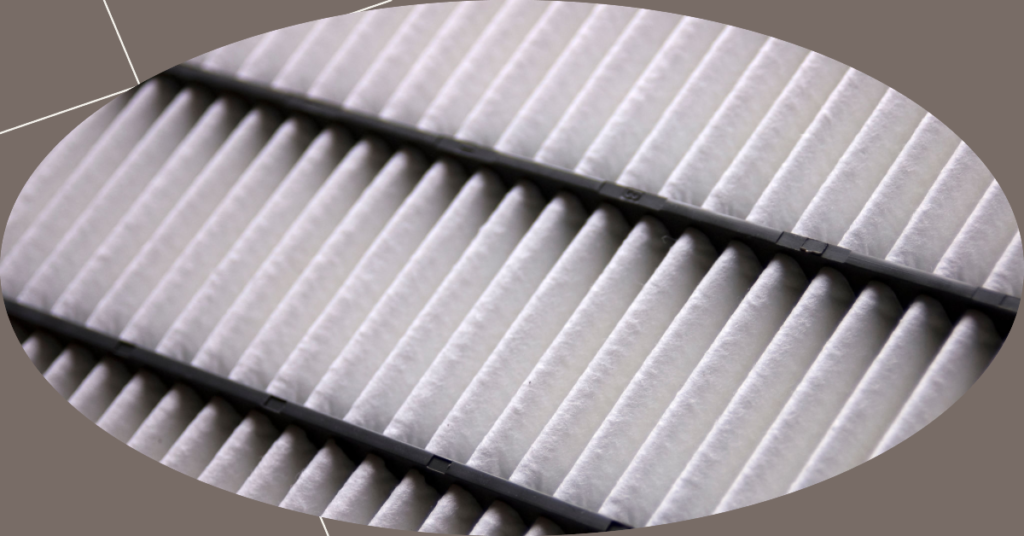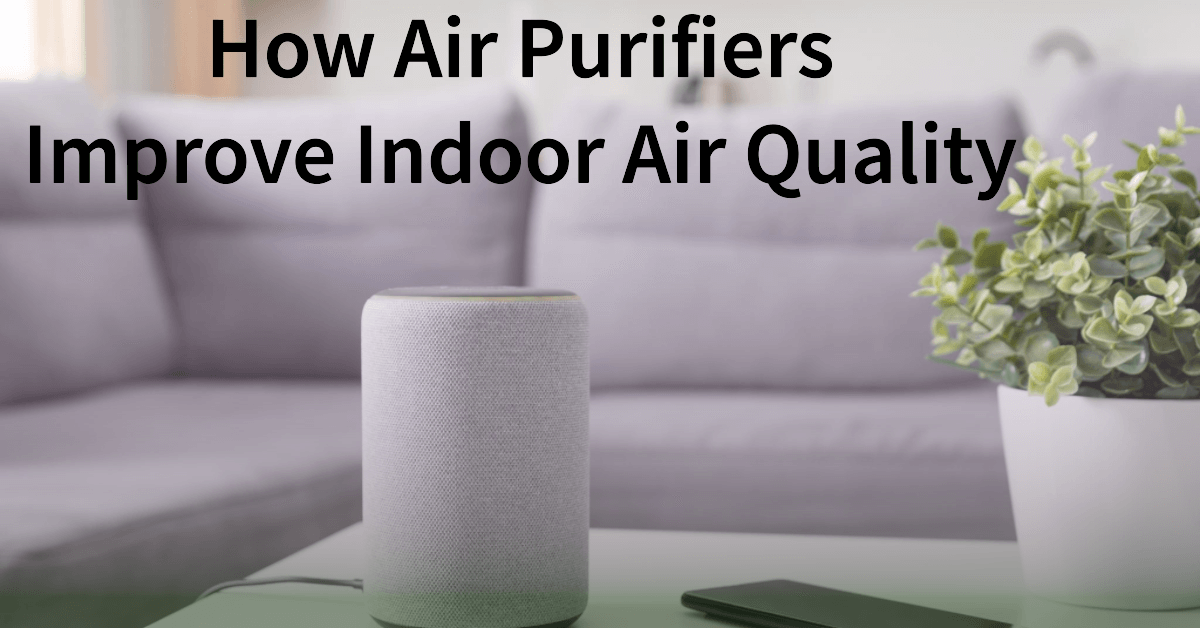It’s essential to explore the question, “How air purifiers improve indoor air quality?”. The air we breathe indoors can often be more polluted than we realize, filled with allergens, dust particles, pet dander and even harmful pollutants. This blog post will delve into the importance of indoor air quality and how air purifiers play a crucial role in enhancing it.
Air purifiers have emerged as a modern solution to address these indoor air quality challenges. Indoor air quality is vital for our health, as we spend a significant amount of time indoors. Poor air quality can lead to allergies, respiratory problems and other health issues. Factors like particulate matter, allergens, volatile organic compounds and tobacco smoke can affect indoor air quality.
Air purifiers are designed to improve indoor air quality by removing harmful particles and pollutants. They use various methods, including mechanical filtration, activated carbon adsorption, UV-C germicidal irradiation and ionic purification. We will also explore additional ways for improving indoor air quality, ensuring a cleaner and healthier living space for you and your loved ones.

Understanding Indoor Air Pollution
To appreciate the importance of air purifiers, it’s essential to understand what we’re up against in our indoor spaces. Indoor air pollution is a real and often underestimated problem. Let’s understand the common indoor air pollutants and the health risks they pose.
Common Indoor Air Pollutants
Common indoor air pollutants include particulate matter (PM), allergens like pollen and pet dander, volatile organic compounds (VOCs) from household products, tobacco smoke and radon gas.
Health Risks Associated with Poor Indoor Air Quality
Poor indoor air quality can pose significant health risks, including respiratory issues like asthma and bronchitis exacerbation, allergic reactions triggered by allergens, eye, nose and throat irritation from irritants like VOCs and tobacco smoke and potentially severe long-term effects like cardiovascular disease and cancer with prolonged exposure.
| Indoor Air Pollutant | Description | Health Risks |
|---|---|---|
| Particulate Matter (PM) | Tiny airborne particles from various sources, including dust, pollen, soot and cooking residues. | Lung penetration, respiratory issues |
| Allergens (Pollen, Pet Dander) | Substances triggering allergies like pollen, pet dander and mold spores, leading to sneezing, itchiness and congestion. | Allergic reactions, discomfort |
| Volatile Organic Compounds (VOCs) | Evaporating chemicals from products like paints and cleaners, causing eye or throat irritation, headaches and more. | Irritation, potential health effects |
| Tobacco Smoke | Harmful chemicals in tobacco smoke, especially secondhand, causing respiratory problems, heart disease and cancer. | Serious health risks for nonsmokers, worsened indoor air quality. |
Now that we’ve explored the common indoor air pollutants and their associated health risks, it becomes clear why taking steps to improve indoor air quality is crucial for our well-being. Now, we’ll understand how air purifiers address these issues and work to create a healthier indoor environment.
Ways Air Purifiers boost Indoor Air Quality
Air purifiers are impressive devices designed to enhance indoor air quality. They utilize various mechanisms and technologies to accomplish this goal. Let’s explore how they work and the ways they can significantly improve the air you breathe.
Air Purifiers With Multi-Layered Filtration Remove More Indoor Contaminants
One of the key strengths of air purifiers lies in their filtration systems. Air purifiers often feature multiple layers of filters designed to capture different types of contaminants. These layers work together to remove a wide range of particles and pollutants from the air.
- Pre-Filter: The first line of defense, a pre-filter, captures larger particles like dust, pet hair and some allergens.
- HEPA Filter: High Efficiency Particulate Air (HEPA) filters are incredibly effective at trapping particles as small as 0.3 microns, including pollen, mold spores and bacteria.
- Activated Carbon Filter: This layer is designed to absorb odors, smoke and volatile organic compounds (VOCs), leaving the air smelling fresher and cleaner.
- Additional Filters: Some advanced air purifiers may include specialized filters for specific purposes, such as capturing ultrafine particles or combating bacteria and viruses.
By utilizing these multiple layers of filtration, air purifiers can effectively remove a wide variety of indoor air pollutants, making your indoor environment healthier and more comfortable.

Air Purifiers Can Capture MPPS (Most Penetrating Particle Size)
Air purifiers have the ability to target what is known as the “Most Penetrating Particle Size” (MPPS). MPPS means the size of particles that can penetrate deep into our respiratory system. Air purifiers are designed to capture particles at or near the MPPS, ensuring that even the tiniest and most harmful particles are removed from the air you breathe.
Air Purifiers Capture Particles as Small as 0.1 Micron Size
Air purifiers are incredibly precise in their operation. Many models are capable of capturing particles as small as 0.1 micron in size. Normally, a human hair is about 70 microns in diameter, so we’re talking about particles that are incredibly tiny. This level of filtration ensures that even the smallest and most harmful particles are effectively removed from the air.
Air Purifiers Remove Common Indoor Contaminants
In addition to capturing particles, air purifiers are adept at eliminating common indoor irritants and allergens. They can effectively remove:
- Odors: Whether it’s cooking smells, pet odors or smoke, air purifiers equipped with activated carbon filters can neutralize unpleasant odors, leaving your home smelling fresh.
- Pet Dander and Hair: If you have pets, air purifiers can help reduce allergens like pet dander and hair, providing relief to those with allergies.
- Dust Mites: These microscopic creatures thrive in indoor environments. Air purifiers with HEPA filters can trap dust mites and their waste products.
- Pollen: During allergy seasons, air purifiers can be a valuable ally in capturing pollen particles, helping to alleviate allergy symptoms.
Air Purifiers Can Give Long-Term Health Benefits
Consistently using an air purifier can lead to significant health improvements along other benefits over time. By reducing exposure to indoor air pollutants, individuals may experience:
- Improved Respiratory Health: Those with asthma or other respiratory conditions often find relief from symptoms like coughing and wheezing.
- Fewer Allergy Symptoms: Reduced exposure to allergens can lead to fewer allergic reactions and milder symptoms.
- Better Overall Well-Being: Breathing cleaner air can contribute to an improved sense of well-being and comfort in your home.

Strategies to Improve Indoor Air Quality
While air purifiers are essential tools for enhancing indoor air quality, they are just one part of the equation. To create the healthiest indoor environment, it’s crucial to follow a holistic approach. Here are some strategies to consider:
Source Control
Source control is the first and most effective way to improve indoor air quality. This strategy focuses on eliminating or reducing the sources of indoor air pollutants. Here are some practical steps you can take:
- Avoid Smoking Indoors: If you or someone in your household smokes, consider quitting or smoking outdoors to prevent the introduction of harmful tobacco smoke indoors.
- Properly Ventilate When Cooking: Cooking can release pollutants into the air. Ensure your kitchen is well ventilated by using exhaust fans or opening windows while cooking.
- Choose Low-VOC Products: When renovating or furnishing your home, opt for low-VOC or VOC-free products, including paints, adhesives and furniture.
- Regular Cleaning: Dust and allergens can accumulate in your home. Regular cleaning, including vacuuming and dusting, can help reduce these contaminants.
Improved Ventilation
Good ventilation plays a critical role in maintaining indoor air quality. Proper ventilation ensures that fresh outdoor air is regularly introduced into your indoor space, diluting pollutants and maintaining a healthier environment. Consider the following:
- Use Exhaust Fans: In areas prone to moisture, such as bathrooms and kitchens, use exhaust fans to remove humid air and pollutants.
- Open Windows: When weather permits, opening windows allows for natural ventilation, helping to remove indoor pollutants and bring in fresh outdoor air.
- Air Exchange Systems: Some homes are equipped with mechanical ventilation systems that continuously exchange indoor and outdoor air.
Air Cleaners
While we’ve already discussed the role of air purifiers, it’s worth reiterating their importance within the context of improving indoor air quality. Air purifiers are highly effective at removing airborne pollutants, providing an added layer of protection for you and your family.
When selecting an air purifier, consider factors such as the size of the room, the type of pollutants you want to target and the filter technology used. This ensures that you choose the most suitable air cleaner for your specific needs.
By combining source control, improved ventilation and the use of air cleaners like air purifiers, you can create a comprehensive strategy to enhance your indoor air quality.

Ways to Improve Your Air Quality at Home
Beyond the use of air purifiers and general strategies, there are several specific actions you can take to further enhance the air quality in your home. Let’s explore these practical steps:
Cut Down on Pollutants
1. Radon
Radon is a colorless, odorless gas that can seep into homes from the ground. It is radioactive and has been linked to lung cancer. To reduce radon exposure:
- Test for Radon: Consider purchasing a radon detection kit to test the radon levels in your home. If high levels are detected then necessary measures can be taken.
2. Secondhand Smoke
Secondhand smoke from cigarettes is a major indoor air pollutant. If you or someone in your household smokes, consider the following:
- Designated Smoking Area: Create a designated outdoor smoking area to prevent smoke from infiltrating your home.
3. Formaldehyde
Formaldehyde is a common indoor air pollutant found in some building materials and household products. To reduce formaldehyde exposure:
- Choose Low-Formaldehyde Products: When purchasing furniture or building materials, select products that have low formaldehyde emissions.
4. Cleaning Products
Many conventional cleaning products contain harsh chemicals that can contribute to indoor air pollution. To minimize exposure:
- Switch to Safer Alternatives: Consider using environmentally friendly and non-toxic cleaning products.
Test Your Air Quality
1. DIY Air Quality Testing
You can take matters into your own hands by conducting DIY air quality testing. There are various kits and devices available that allow you to assess the air quality in your home. These tests can provide insights into pollutant levels and guide your efforts to improve indoor air quality.
2. Professional Air Quality Testing
For a more comprehensive assessment, consider hiring a professional indoor air quality testing service. Professionals can identify specific pollutants and offer recommendations for remediation.
Improve Ventilation
Good ventilation is essential for maintaining clean indoor air. Here are ways to enhance ventilation:
- Use Exhaust Fans: Install exhaust fans in kitchens and bathrooms to remove excess moisture and pollutants.
- Regularly Ventilate: Open windows and doors regularly to allow fresh outdoor air to circulate through your home.
Reduce Dampness
Excess moisture in your home can lead to mold growth and worsen indoor air quality. To reduce dampness:
- Use Dehumidifiers: Dehumidifiers can help maintain optimal humidity levels in your home, preventing mold and mildew growth.
Check on Your Heating Systems
Heating systems can contribute to indoor air pollution if not properly maintained. Consider the following:
- Regular Maintenance: Ensure that your heating systems, including furnaces and wood-burning stoves, are regularly serviced to prevent the release of harmful emissions.
Use Indoor Plants Effectively
Certain indoor plants can help improve air quality by absorbing pollutants. Consider adding plants like spider plants, snake plants and peace lilies to your indoor spaces to naturally filter the air.
By implementing these practical steps, you can further enhance the quality of the air you breathe indoors. These measures, combined with air purifiers and other strategies, will contribute to a healthier and more comfortable living environment.

Maintaining and Maximizing Air Purifier Efficiency
Air purifiers are powerful tools for improving indoor air quality, but to ensure they work at their best, they require some care and attention. Let’s explore how to maintain and maximize the efficiency of your air purifier:
Regular Cleaning and Maintenance
Just like any other appliance, air purifiers need regular cleaning and maintenance to function effectively over time. Here’s what you can do:
- Change Filters: Follow the manufacturer’s recommendations for filter replacement. Most air purifiers have a filter indicator that will alert you when it’s time to change the filters.
- Clean Pre-Filters: If your air purifier has a pre-filter, clean it regularly to prevent it from clogging with larger particles like dust and pet hair.
- Wipe Down Exterior: Clean the exterior of the air purifier to remove dust and grime that can accumulate over time.
- Check for Leaks: Inspect the air purifier for any signs of leaks or damage to ensure it’s operating safely.
Proper Placement Within the Room
Where you place your air purifier can significantly impact its effectiveness. Here are some placement tips:
- Central Location: Position the air purifier in a central location within the room to ensure maximum air circulation.
- Avoid Obstructions: Keep the air purifier away from walls, furniture and other obstructions that can block airflow.
- Bedroom Placement: Placing an air purifier in the bedroom can be particularly beneficial since we spend a significant portion of our day sleeping and clean air can contribute to better rest.
- Avoid Drafts: Avoid placing the air purifier directly in the path of drafts or vents, as this can affect its performance.
Understanding Air Purifier Limitations
While air purifiers are powerful tools, it’s essential to understand their limitations:
- Size Matters: Ensure that your air purifier is appropriately sized for the room. If it’s too small, it may not effectively clean the air in larger spaces.
- Particle Size: Not all air purifiers are equally effective at capturing ultrafine particles or gases. Choose a model that suits your specific needs.
- No Substitute for Source Control: Air purifiers can help remove pollutants, but they are not a substitute for eliminating pollution sources. Continue to implement source control strategies.
- Noise Level: Some air purifiers can be noisy, especially on higher fan settings. Consider noise levels if you plan to use an air purifier in a quiet space like a bedroom.
By regularly maintaining your air purifier, placing it strategically within the room and understanding its limitations, you can ensure that it continues to provide clean, healthy air for your indoor environment.
Environmental Considerations
While air purifiers are essential for improving indoor air quality, it’s also crucial to consider their environmental impact and explore eco-friendly alternatives and practices.
The Environmental Impact of Air Purifiers
Air purifiers, like many household appliances, have both positive and negative environmental aspects to consider:
- Energy Consumption: Some air purifiers can consume a significant amount of energy, contributing to higher electricity bills and increased greenhouse gas emissions if not used efficiently.
- Filter Disposal: Filters used in air purifiers need to be replaced periodically and some filters can be challenging to recycle. Proper disposal and recycling of filters are essential to minimize environmental impact.
- Manufacturing and Materials: Consider the materials used in the construction of air purifiers and their manufacturing processes. Look for products that prioritize sustainability and eco-friendly materials.
Eco-Friendly Alternatives and Practices
To minimize the environmental impact of air purifiers and maintain a sustainable lifestyle, consider the following alternatives and practices:
- Energy-Efficient Models: Choose energy-efficient air purifiers with lower energy consumption, which can reduce both your energy bills and environmental footprint.
- Eco-Friendly Filters: Look for air purifiers that use washable or reusable filters, which can reduce the amount of disposable waste generated.
- Natural Ventilation: In milder weather conditions, use natural ventilation by opening windows and doors to bring in fresh outdoor air.
- Reduce Pollutant Sources: Implement source control strategies to reduce the need for air purifiers, such as quitting smoking or choosing low-VOC products.
Conclusion
Indoor air quality is a crucial aspect of our overall well-being and it deserves our attention and care. We’ve explored the critical role of air purifiers in enhancing indoor air quality, but they are just one piece of the puzzle. Remember that investing in the quality of the air you breathe is an investment in your long-term health and well-being and it’s a step towards a healthier and more sustainable future.
FAQ on How Air Purifiers Improve Indoor Air Quality
Do air purifiers improve indoor air quality?
Air purifiers are designed to remove various contaminants like dust, pollen, smoke, pet dander and pollutants from the air. They use filters or other technologies to capture these particles, thus improving indoor air quality by reducing the concentration of these harmful substances. However, the extent of improvement depends on factors like the purifier’s efficiency, the type of pollutants present and the room size.
How much does an air purifier improve air quality?
The extent of air quality improvement depends on various factors, including the air purifier’s effectiveness in removing specific pollutants, the room’s size and the initial air quality. Air purifiers can significantly reduce airborne particles and allergens, but they may not eliminate all pollutants, such as gases or chemicals.
How to get better air quality in a room?
To enhance air quality in a room, consider:
Using an air purifier to remove particles and pollutants.
Ensuring good ventilation by opening windows and using exhaust fans.
Keeping your home clean, including regular dusting and vacuuming.
Reducing indoor pollution sources, like smoking or using harsh chemicals.
Maintaining proper humidity levels, typically between 30% and 50%, to prevent mold and allergen growth.
Do air purifiers measure air quality?
Some advanced air purifiers have built-in sensors to measure air quality, but most basic models do not. For precise air quality measurements, a separate air quality monitor is recommended.
Why do we need indoor air purifiers?
Indoor air purifiers are essential for removing contaminants, allergens and pollutants, providing cleaner air for breathing and reducing health risks associated with poor indoor air quality, especially for those with allergies or respiratory conditions.
Do air purifiers really work?
Yes, air purifiers effectively remove specific contaminants from the air, but their effectiveness depends on factors such as the type of purifier, the quality of filters used and the nature of the pollutants present.
How can I improve the air quality in my indoor bedroom?
To enhance bedroom air quality, use an air purifier, keep windows open for fresh air, wash bedding regularly, maintain cleanliness and manage humidity levels.
Does a humidifier improve air quality?
While humidifiers add moisture to the air, which can be beneficial for respiratory comfort, they do not directly remove pollutants. Air purifiers are more effective for improving air quality by removing particles and contaminants.
How do I get rid of heavy air in my house?
To alleviate stagnant or heavy air, ensure proper ventilation, use air purifiers and address potential sources of indoor pollution.
What are three reasons for poor indoor air quality?
Three common reasons for poor indoor air quality are inadequate ventilation, the presence of indoor pollutants (e.g., tobacco smoke, chemicals) and high humidity or moisture levels fostering mold growth.
What are the top four indoor air pollutants in the United States?
In the United States, the top indoor air pollutants include tobacco smoke, radon gas, volatile organic compounds (VOCs) from household products and particulate matter (PM) from sources like cooking and cleaning.
Why is indoor air quality worse?
Indoor air quality can be worse than outdoor air due to factors like limited ventilation, increased use of synthetic materials and the accumulation of indoor pollutants.
What are 5 effects of poor air quality?
Poor air quality can lead to respiratory problems (coughing, wheezing), allergies, worsened asthma symptoms, fatigue and reduced overall comfort and well-being.
DheerajSonwane is a dedicated writer with expertise in air purification technologies. He focuses on providing well-researched content to help readers improve indoor air quality in homes and businesses. As the lead writer at AirPurifierMaster.com, Dheeraj offers practical advice his insightful reviews guide individuals in choosing the best air purifiers for their needs.


1 thought on “How Air Purifiers Improve Indoor Air Quality”